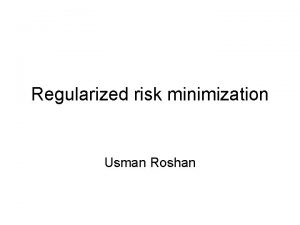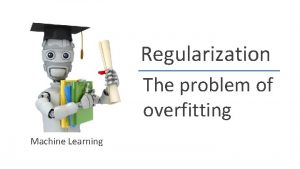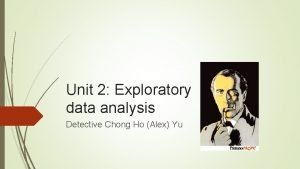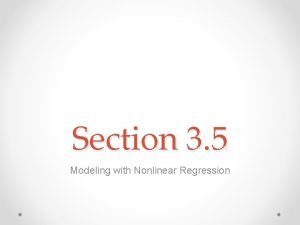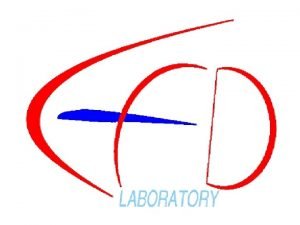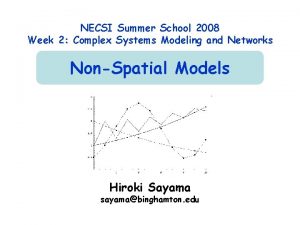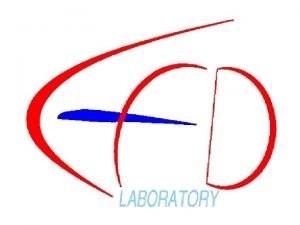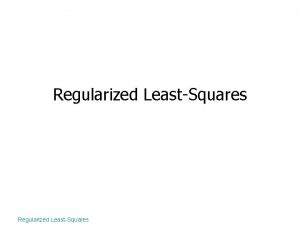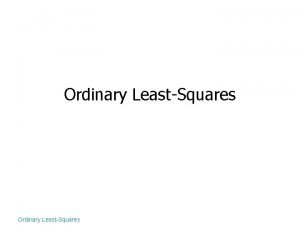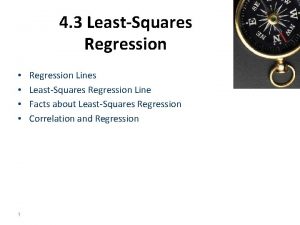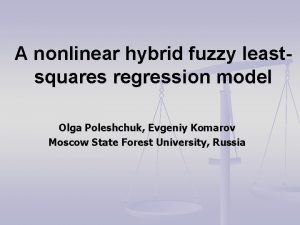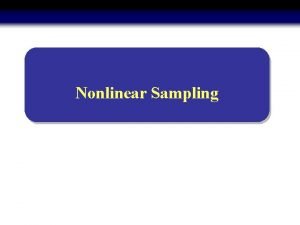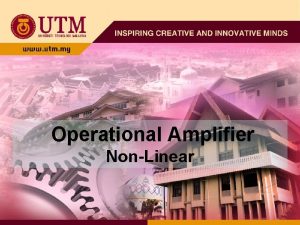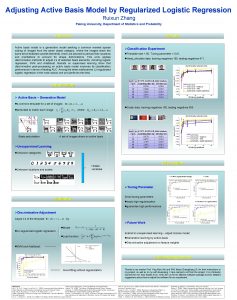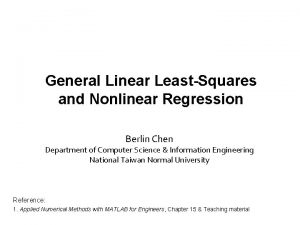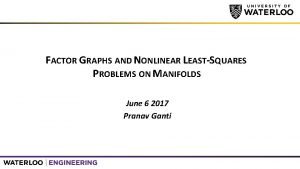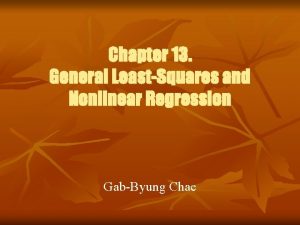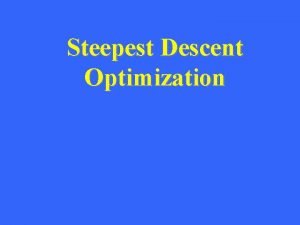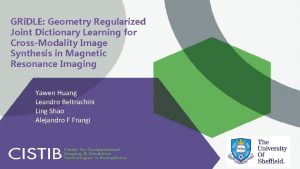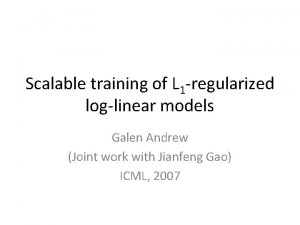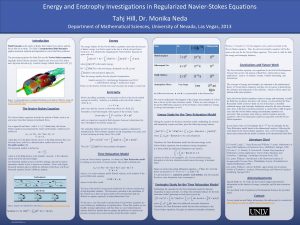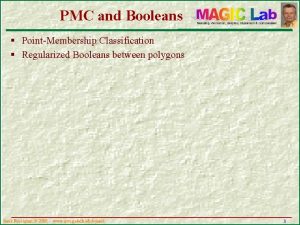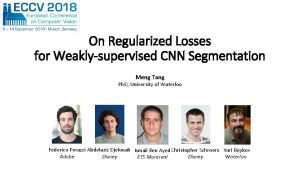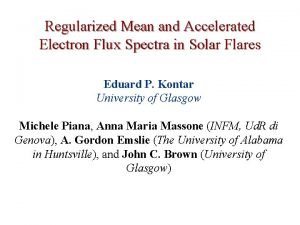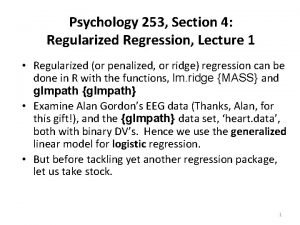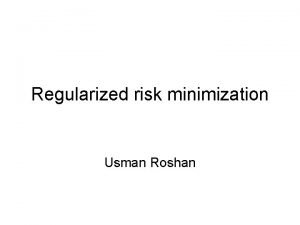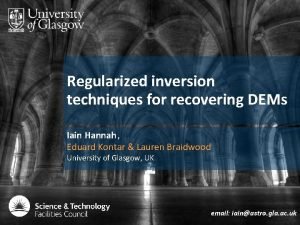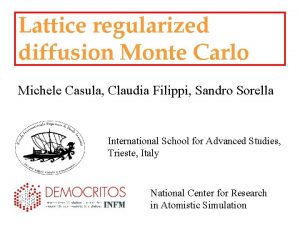Nonlinear LeastSquares Regularized LeastSquares Why nonlinear The model






































- Slides: 38

Non-linear Least-Squares Regularized Least-Squares

Why non-linear? • The model is non-linear (e. g. joints, position, . . ) • The error function is non-linear Regularized Least-Squares

Setup • Let f be a function such that where x is a vector of parameters Regularized Least-Squares

Setup • Let f be a function such that where x is a vector of parameters • Let {ak, bk} be a set of measurements/constraints. We fit f to the data by solving: Regularized Least-Squares

Setup • Let f be a function such that where x is a vector of parameters • Let {ak, bk} be a set of measurements/constraints. We fit f to the data by solving: Regularized Least-Squares

Example Regularized Least-Squares

Overview • • • Existence and uniqueness of minimum Steepest-descent Newton’s method Gauss-Newton’s method Levenberg-Marquardt method Regularized Least-Squares

A non-linear function: the Rosenbrock function Global minimum at (1, 1) Regularized Least-Squares

Existence of minimum A local minima is characterized by: 1. 2. Regularized Least-Squares

Existence of minimum Regularized Least-Squares

Descent algorithm • Start at an initial position x 0 • Until convergence – Find minimizing step dxk – xk+1=xk+ dxk Produce a sequence x 0, x 1, …, xn such that f(x 0) > f(x 1) > …> f(xn) Regularized Least-Squares

Descent algorithm • Start at an initial position x 0 • Until convergence – Find minimizing step dxk using a local approximation of f – xk+1=xk+ dxk Produce a sequence x 0, x 1, …, xn such that f(x 0) > f(x 1) > …> f(xn) Regularized Least-Squares

Approximation using Taylor series Regularized Least-Squares

Approximation using Taylor series Regularized Least-Squares

Approximation using Taylor series Regularized Least-Squares

Steepest descent Step where is chosen such that: using a line search algorithm: Regularized Least-Squares

Regularized Least-Squares

Regularized Least-Squares

In the plane of the steepest descent direction Regularized Least-Squares

Rosenbrock function (1000 iterations) Regularized Least-Squares

Newton’s method • Step: second order approximation At the minimum of N Regularized Least-Squares

Regularized Least-Squares

Problem • If is not positive semi-definite, then is not a descent direction: the step increases the error function • Uses positive semi-definite approximation of Hessian based on the jacobian (quasi-Newton methods) Regularized Least-Squares

Gauss-Newton method Step: use with the approximate hessian Advantages: • No second order derivatives • is positive semi-definite Regularized Least-Squares

Rosenbrock function (48 evaluations) Regularized Least-Squares

Levenberg-Marquardt algorithm • Blends Steepest descent and Gauss-Newton • At each step solve, for the descent direction Regularized Least-Squares

Managing the damping parameter • General approach: – If step fails, increase damping until step is successful – If step succeeds, decrease damping to take larger step • Improved damping Regularized Least-Squares

Rosenbrock function (90 evaluations) Regularized Least-Squares

“Resynthesizing Facial Animation through 3 D Model-Based Tracking”, Pighin etal. , + + Video frame Regularized Least-Squares Model

Model fitting + Video frame Regularized Least-Squares + + + Model 2

Model fitting + Video frame Regularized Least-Squares 2 + + + Model Fitted model

“Resynthesizing Facial Animation through 3 D Model -Based Tracking”, Pighin etal. , • Facial tracking by fitting face model Regularized Least-Squares

“Resynthesizing Facial Animation through 3 D Model -Based Tracking”, Pighin etal. , • Facial tracking by fitting face model • Problem – Given an image I – A 3 D face model Regularized Least-Squares

“Resynthesizing Facial Animation through 3 D Model -Based Tracking”, Pighin etal. , • Facial tracking by fitting face model • Problem – Given an image I – A 3 D face model Minimize Where And is the image produced by the face model is a regularization term. Regularized Least-Squares

Problem setup Regularized Least-Squares

Solving • Using a gaussian pyramid of the input image • For level in [coarser. Level : finer. Lever] – Initialize using solution at level-1 – Minimize at level using Levenberg-Marquardt Solution is solution at finer. Level Regularized Least-Squares

Tracking results Regularized Least-Squares

Conclusion • Get a good initial guess Prediction (temporal/spatial coherency) Partial solve Prior knowledge • Levenberg-Marquardt is your friend Regularized Least-Squares
 Regularized risk minimization
Regularized risk minimization Logistic regression andrew ng
Logistic regression andrew ng Andreas carlsson bye bye bye
Andreas carlsson bye bye bye Dont ask why why why
Dont ask why why why Nonlinear model
Nonlinear model 3-5 modeling with nonlinear regression
3-5 modeling with nonlinear regression Nonlinear model
Nonlinear model Nonlinear model
Nonlinear model Nonlinear model
Nonlinear model Hình ảnh bộ gõ cơ thể búng tay
Hình ảnh bộ gõ cơ thể búng tay Lp html
Lp html Bổ thể
Bổ thể Tỉ lệ cơ thể trẻ em
Tỉ lệ cơ thể trẻ em Voi kéo gỗ như thế nào
Voi kéo gỗ như thế nào Chụp phim tư thế worms-breton
Chụp phim tư thế worms-breton Chúa sống lại
Chúa sống lại Môn thể thao bắt đầu bằng từ đua
Môn thể thao bắt đầu bằng từ đua Thế nào là hệ số cao nhất
Thế nào là hệ số cao nhất Các châu lục và đại dương trên thế giới
Các châu lục và đại dương trên thế giới Cong thức tính động năng
Cong thức tính động năng Trời xanh đây là của chúng ta thể thơ
Trời xanh đây là của chúng ta thể thơ Cách giải mật thư tọa độ
Cách giải mật thư tọa độ 101012 bằng
101012 bằng độ dài liên kết
độ dài liên kết Các châu lục và đại dương trên thế giới
Các châu lục và đại dương trên thế giới Thơ thất ngôn tứ tuyệt đường luật
Thơ thất ngôn tứ tuyệt đường luật Quá trình desamine hóa có thể tạo ra
Quá trình desamine hóa có thể tạo ra Một số thể thơ truyền thống
Một số thể thơ truyền thống Cái miệng bé xinh thế chỉ nói điều hay thôi
Cái miệng bé xinh thế chỉ nói điều hay thôi Vẽ hình chiếu vuông góc của vật thể sau
Vẽ hình chiếu vuông góc của vật thể sau Biện pháp chống mỏi cơ
Biện pháp chống mỏi cơ đặc điểm cơ thể của người tối cổ
đặc điểm cơ thể của người tối cổ Thế nào là giọng cùng tên
Thế nào là giọng cùng tên Vẽ hình chiếu đứng bằng cạnh của vật thể
Vẽ hình chiếu đứng bằng cạnh của vật thể Tia chieu sa te
Tia chieu sa te Thẻ vin
Thẻ vin đại từ thay thế
đại từ thay thế điện thế nghỉ
điện thế nghỉ Tư thế ngồi viết
Tư thế ngồi viết
